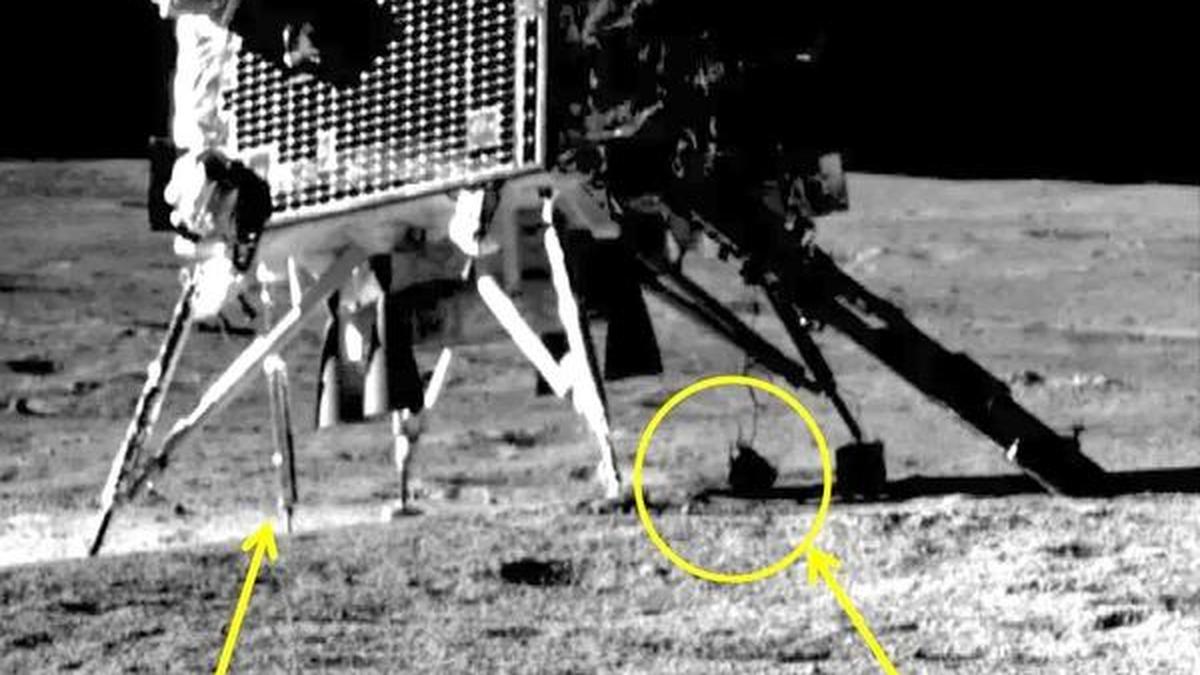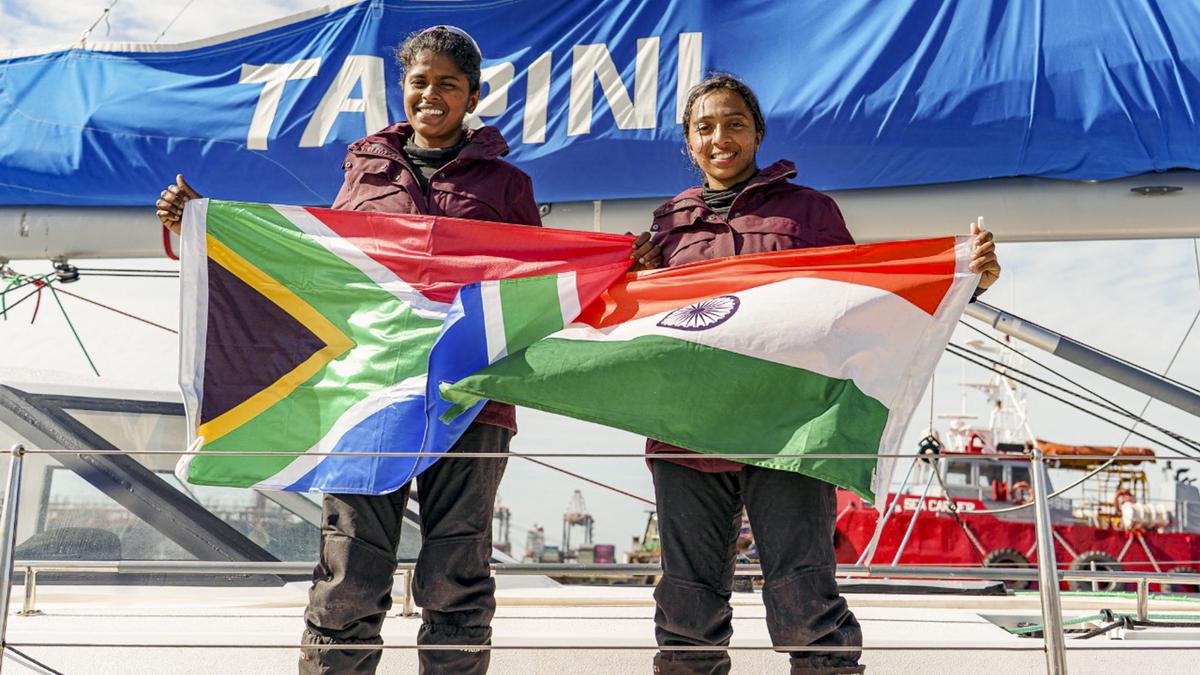Chandra’s Surface Thermophysical Experiment (ChaSTE)

- 04 Apr 2025
In News:
India’s Chandrayaan-3 mission, which successfully landed on the Moon’s south polar region on August 23, 2023, achieved a global first with its Chandra’s Surface Thermophysical Experiment (ChaSTE) — the first thermal probe to successfully penetrate the soil of a celestial body and measure subsurface temperatures in situ.
About ChaSTE:
- Full form: Chandra’s Surface Thermophysical Experiment.
- Part of: Vikram lander (Chandrayaan-3).
- Depth achieved: Successfully tunnelled10 cm into the lunar regolith.
- Duration of operation: From August 23 to September 2, 2023.
- Significance: First successful deployment of a thermal probe into extraterrestrial soil.
Key Features:
- Temperature sensors: 10 sensors spaced 1 cm apart near the probe’s tip.
- Deployment mechanism: Unique rotation-based system — unlike previous missions that used hammering mechanisms.
- Measurement technique: Monitored changes in motor resistance and tip temperature to determine soil contact and depth.
Scientific Outcomes:
- Provided direct temperature profiles of lunar subsurface near the south pole.
- Enabled insights suggesting greater-than-expected presence of water ice beneath the surface.
Comparison with Previous Attempts:
Mission Agency Celestial Body Instrument Outcome
Rosetta – Philae (2014) ESA Comet 67P MUPUS Deployment failed due to
landing bounce
InSight (2018) NASA Mars HP3 ("The Mole") Could not collect data;
probe failed to burrow
as intended
Chandrayaan-3 (2023) ISRO Moon ChaSTE Successful soil
penetration and
temperature measurement
- Innovation Edge: Unlike ESA’s and NASA’s hammer-based devices, ChaSTE used a rotating drill, allowing steady penetration despite lunar soil resistance.
- Developed by the Physical Research Laboratory (PRL), Ahmedabad.
INSV Tarini at Cape Town

- 04 Apr 2025
In News:
The Indian Naval Sailing Vessel (INSV) Tarini, crewed by women officers Lt CdrDilna K. and Lt Cdr Roopa A., reached Cape Town, South Africa, marking the final international port in the Navika Sagar Parikrama II — a global circumnavigation mission by the Indian Navy.
About INSV Tarini:
- Type: 56-foot indigenously built sailing vessel.
- Commissioned: February 2017.
- Builder:Aquarius Shipyard Ltd., Goa, under the Make in India initiative.
- Features:
- Equipped with Raymarine navigation suite, satellite communication systems, and emergency steering.
- Designed to operate in extreme maritime conditions.
- Name Origin: Named after the Tara-Tarini hill shrine in Odisha; ‘Tarini’ in Sanskrit means “boat” and “saviour.”
Navika Sagar Parikrama II:
- Flagged off from Goa: October 2, 2024, by Admiral Dinesh K. Tripathi, Chief of the Naval Staff.
- Duration: ~8 months.
- Total distance: Approx. 23,400 nautical miles (43,300 km).
- Route across three oceans, rounding three major capes.
- Ports of call before Cape Town:
- Fremantle (Australia)
- Lyttelton (New Zealand)
- Port Stanley (Falkland Islands, UK)
Challenges Faced:
- Extreme weather: Winds > 50 knots (93 km/h), waves up to 7 metres.
- Rough seas and cold temperatures posed significant navigational challenges.
Significance:
- Demonstrates India’s commitment to women-led maritime expeditions.
- Strengthens India–South Africa naval cooperation:
- October 2024: INS Talwar participated in Exercise IBSAMAR.
- January 2025: INS Tushil made a port call at Durban.
Protection of Interests in Aircraft Objects Bill, 2025

- 04 Apr 2025
In News:
The Protection of Interests in Aircraft Objects Bill, 2025, recently passed by the Rajya Sabha, aims to implement two key international agreements in India’s legal framework:
- Cape Town Convention on International Interests in Mobile Equipment (2001)
- Protocol to the Convention on Matters Specific to Aircraft Equipment
Objective:
To provide legal clarity and security to stakeholders in the aviation leasing industry by integrating global standards into Indian law.
Background:
- India became a signatory in 2008 after Cabinet ratification in 2007.
- The Cape Town Convention addresses complex issues of cross-border leasing and financing of high-value mobile assets like aircraft, helicopters, and engines.
- With over 86.4% of India's 840 commercial aircraft under leasing arrangements, there was an urgent need for a dedicated legal framework.
Key Provisions:
- Directorate General of Civil Aviation (DGCA) is designated as the registry authority.
- Responsible for registration and deregistration of aircraft.
- Creditors must notify the DGCA prior to initiating recovery actions in case of defaults.
- In case of default by airlines:
- Creditors can reclaim aircraft or related equipment within two months, or as per a mutually agreed period.
- Lessors and airlines are required to regularly inform the DGCA about dues and lease activities.
- The central government is empowered to make rules for the implementation of the convention and protocol.
Expected Benefits:
- Enhances legal protection for creditors and lessors.
- Reduces leasing costs by an estimated 8–10%, potentially lowering airfares for consumers.
- Encourages the growth of a domestic aircraft leasing industry, reducing dependence on foreign jurisdictions like Ireland, Singapore, and Dubai.
Civil Aviation Minister’s Remarks:
- The Bill addresses a long-standing legislative vacuum.
- It will bolster investor confidence and attract leasing businesses to India.
- Airfare regulation remains complex and is influenced by multiple factors including fuel prices, leasing charges, and maintenance costs.
India’s Agricultural Trade Dilemma
- 04 Apr 2025
In News:
India faces growing global pressure to liberalise its agricultural markets amidst trade negotiations, FTAs, and WTO commitments. At the same time, ensuring food security and protecting rural livelihoods remains a domestic priority.
Benefits of Global Trade Integration
- Export Revenue Growth: Enhanced access to global markets has increased agri-exports.E.g., India’s agricultural exports to the US were worth $8.4 billion.
- Technology & Investment Inflow: FTAs can attract agri-tech innovations and cold-chain infrastructure.E.g., partnerships with developed nations enable modernisation of storage and logistics.
- Market Efficiency: Global competition improves price discovery and benefits quality producers.
- Geopolitical Leverage: Trade agreements strengthen India’s role in forums like the WTO and BRICS.
- Input Security via Diversified Imports: Import of essentials like palm oil and fertilisers protects supply chains. E.g., Indonesia’s 2022 palm oil export ban highlighted India’s vulnerability.
Importance of Domestic Food Security
- Rural Livelihoods: Agriculture employs ~42% of the workforce, primarily small and marginal farmers.Over 100 million dairy farmers depend on protective tariffs.
- Nutrition and Price Stability: Domestic self-sufficiency guards against global price shocks.
- Reduced Import Dependence: A strong domestic base cushions India during crises.E.g., Ukraine war caused a spike in fertiliser prices, exposing dependency.
- Political and Strategic Stability: Ensures rural harmony and policy autonomy.
Challenges of Trade Liberalisation
- Subsidy Imbalances: Developed nations offer massive farm subsidies.E.g., US farm aid of $10 billion distorts global price competitiveness.
- FTA Pressures: Demands from countries like New Zealand to lower dairy tariffs threaten Indian farmers.
- WTO Constraints: India’s MSP system faces scrutiny under global trade rules.
- Illegal Imports: Despite bans, cheap imports like Chinese garlic infiltrate markets, undermining domestic prices.
- Retaliatory Tariffs: India’s high tariffs invite reciprocal duties.E.g., the US “reciprocal tariff” policy under Trump era.
Macroeconomic Risks
- Rural Unemployment: Liberalisation could displace small-scale farmers.
- Trade Deficit Worsening: Import liberalisation without export flexibility can widen the deficit.
- Revenue Loss: Tariff cuts may reduce fiscal space for welfare schemes.
- Exposure to Global Shocks:E.g., Ukraine war disrupted fertiliser supply; Indonesia’s ban hiked edible oil prices by 27% in India.
Way Forward
India must adopt a calibrated, strategic approach:
- Selective Liberalisation: Lower tariffs only in non-sensitive sectors while safeguarding essential crops.
- Investment-Oriented FTAs: Prioritise infrastructure, tech transfer, and rural development over tariff cuts.
- Domestic Strengthening: Boost agri-logistics, seed innovation, and food processing capabilities.
- Trade Vigilance: Strengthen customs and surveillance to prevent substandard or banned imports.
- WTO Reforms: Advocate for fair subsidy norms and transparent trade rules.
Naini Lake
- 04 Apr 2025
In News:
Naini Lake record-low water levels in 2025.
Geographical and Environmental Significance
- Location: Heart of Nainital, Uttarakhand.
- Type: Natural, kidney-shaped freshwater lake.
- Surroundings: Enclosed by seven hills.
- Deepest Point: 89 feet.
- Gauge Level: 12 feet (normal level).
- Water Level (2025): 4.7 feet – lowest in 5 years, nearing “zero level”.
- Zero Level Meaning: Water level below normal gauge, not fully dry.
Ecological & Civic Importance
- Water Source: Supplies 10 million litres/day of drinking water.
- 2024 Dependence: Met 76% of Nainital’s water demand.
- Aquifer Recharge:Sukhatal Lake is a major recharge zone.
Factors Behind Depletion
1. Climate Variability
- Rising Temperatures: +1.5°C rise in Uttarakhand (1970–2022).
- Rainfall Data:
- 2022: 2400 mm (good year).
- 2024: Dropped to 2000 mm.
- Winter Rainfall (Jan–Mar 2025): 107 mm.
- Snowfall Days:
- 2022: Four.
- 2025: None.
2. Anthropogenic Pressures
- Urbanisation& Encroachment:
- Concrete construction → low rainwater infiltration.
- Encroachments on wetlands and recharge zones.
- Pollution Issues:
- Untreated wastewater discharge.
- Improper solid waste disposal.
- Overflowing sewage into stormwater drains.
- Tourism & Homestays:
- High tourist influx.
- Rise in homestays; ~1 in 3 houses converted.
Institutional & Governance Challenges
- Overlapping Jurisdictions:
- Inadequate coordination among agencies.
- Aging Infrastructure:
- Old water distribution system, unable to meet demand.
- Reports Highlighting Issues:
- USCST 2017:Naini Lake most manipulated among Kumaon lakes.
- 2024 Research (CEDAR): Faulty water governance exacerbating stress.
Legal and Civic Interventions
- SC Intervention (1993): Ban on commercial complex projects.
- Uttarakhand HC (2022): Stay on Sukhatal beautification project.
- Petitions Filed: Alleging degradation due to construction on recharge areas.
Way Forward
- Ecosystem-Based Approach: Recognize catchment area, slope vulnerability, and recharge zones.
- Rejuvenation Focus:Prioritisenatural hydrological restoration over tourism promotion.
- Sustainable Urban Planning: Regulation of construction, homestays, and infrastructure development.
